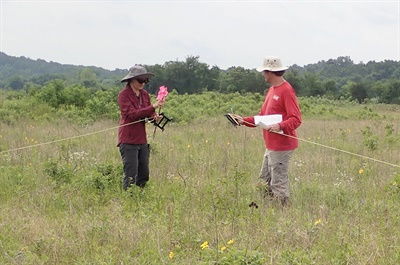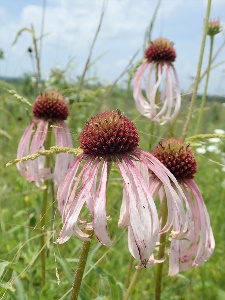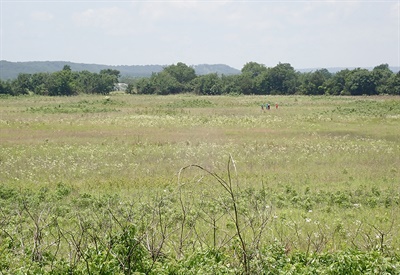ANHC Botanist Diana Soteropoulos recently conducted plant surveys at Cherokee Prairie Natural Area (NA), one of the largest remaining tracts of tallgrass prairie in the Arkansas Valley. The survey was part of an ongoing effort to conduct plant inventories at all ANHC natural areas. Diana was joined by fellow researchers Dr. Travis Marsico, botany professor at Arkansas State University; Ben Benton, graduate student at Arkansas State University and former ANHC intern; and amateur botanist John Michael Kelley.
 The team systematically examined a 10x10 meter plot on their hands and knees, making note of every individual plant species they saw. Consulting with each other and drawing on each other’s expertise, they identified a total of 67 plant species within the plot. A total of three plots were surveyed within the 584-acre natural area. The data collected will be used by researchers studying topics such as the quantity and diversity of plant species, and which species grow together in particular habitats. lt will support ANHC and partner projects, such as the ranking of native plants based on their tolerance to human disturbance, known as Coefficients of Conservatism, or C-values. (Photo at left -- ANHC Botanist Diana Soteropoulos and Dr. Travis Marsico, botany professor at Arkansas State University, delineate a plot to study at Cherokee Prairie Natural Area, photo by Leslie Patrick.)
The team systematically examined a 10x10 meter plot on their hands and knees, making note of every individual plant species they saw. Consulting with each other and drawing on each other’s expertise, they identified a total of 67 plant species within the plot. A total of three plots were surveyed within the 584-acre natural area. The data collected will be used by researchers studying topics such as the quantity and diversity of plant species, and which species grow together in particular habitats. lt will support ANHC and partner projects, such as the ranking of native plants based on their tolerance to human disturbance, known as Coefficients of Conservatism, or C-values. (Photo at left -- ANHC Botanist Diana Soteropoulos and Dr. Travis Marsico, botany professor at Arkansas State University, delineate a plot to study at Cherokee Prairie Natural Area, photo by Leslie Patrick.)
Prairie plants found on the natural area, and other remnants like it, increase our knowledge of prairies and the plants and animals that depend on them. Prairie plants provide a valuable seed source for restoration efforts on other conservation lands. In addition, prairies support hundreds of species of grasses, sedges, wildflowers, and shrubs, as well as a variety of wildlife including quail (also called northern bobwhite, Colinus virginianus) and pollinators.
 A number of showy wildflowers are in bloom at Cherokee Prairie NA this spring/early summer. The tall stems and drooping petals of pale purple coneflower (Echinacea pallida) are easy to spot, swaying in the prairie breeze. The red-orange spikes of Indian paintbrush (Castilleja coccinea) and the brilliant blue flowers of Carolina larkspur (Delphinium carolinianum ssp. carolinianum) also stand out. A closer look, and visitors will find Carolina rose (Rosa carolina) or perhaps, ragged fringed orchid (Platanthera lacera) in bloom. (Photo at left -- Pale purple coneflower (Echinacea pallida) at Cherokee Prairie Natural Area, photo by Leslie Patrick.)
A number of showy wildflowers are in bloom at Cherokee Prairie NA this spring/early summer. The tall stems and drooping petals of pale purple coneflower (Echinacea pallida) are easy to spot, swaying in the prairie breeze. The red-orange spikes of Indian paintbrush (Castilleja coccinea) and the brilliant blue flowers of Carolina larkspur (Delphinium carolinianum ssp. carolinianum) also stand out. A closer look, and visitors will find Carolina rose (Rosa carolina) or perhaps, ragged fringed orchid (Platanthera lacera) in bloom. (Photo at left -- Pale purple coneflower (Echinacea pallida) at Cherokee Prairie Natural Area, photo by Leslie Patrick.)
Located just north of Charleston in Franklin County, Cherokee Prairie NA was added to the System of Natural Areas in 1983. The natural area is home to more than 320 plants, some of which are of state conservation concern. It provides habitat for rare grassland birds, like Le Conte’s sparrow (Ammonspiza leconteii) and Henslow’s sparrow (Centronyx henslowii). Cherokee Prairie NA is one of the few areas of the state where northern bobwhite (quail) are fairly common. It is home to the federally threatened American burying beetle (Nicrophorus americanus); the prairie mole cricket (Gryllotalpa major), an insect of conservations concern; and the Arogos skipper (Atrytone arogos iowa), a butterfly of state conservation concern.
 There are no trails at the natural area, but visitors can walk freely through the area. Travel is limited to foot traffic only, in order to minimize erosion and disturbance to sensitive areas. Cherokee Prairie NA is part of the Cherokee Prairie Natural Area Wildlife Management Area (WMA) managed by the Arkansas Game and Fish Commission (AGFC). More information about hunting season dates and regulations can be found in the current AGFC Hunting Guidebook. (Photo above -- The plant survey crew as seen from a distance at Cherokee Prairie Natural Area, photo by Leslie Patrick.)
There are no trails at the natural area, but visitors can walk freely through the area. Travel is limited to foot traffic only, in order to minimize erosion and disturbance to sensitive areas. Cherokee Prairie NA is part of the Cherokee Prairie Natural Area Wildlife Management Area (WMA) managed by the Arkansas Game and Fish Commission (AGFC). More information about hunting season dates and regulations can be found in the current AGFC Hunting Guidebook. (Photo above -- The plant survey crew as seen from a distance at Cherokee Prairie Natural Area, photo by Leslie Patrick.)
 The team systematically examined a 10x10 meter plot on their hands and knees, making note of every individual plant species they saw. Consulting with each other and drawing on each other’s expertise, they identified a total of 67 plant species within the plot. A total of three plots were surveyed within the 584-acre natural area. The data collected will be used by researchers studying topics such as the quantity and diversity of plant species, and which species grow together in particular habitats. lt will support ANHC and partner projects, such as the ranking of native plants based on their tolerance to human disturbance, known as Coefficients of Conservatism, or C-values. (Photo at left -- ANHC Botanist Diana Soteropoulos and Dr. Travis Marsico, botany professor at Arkansas State University, delineate a plot to study at Cherokee Prairie Natural Area, photo by Leslie Patrick.)
The team systematically examined a 10x10 meter plot on their hands and knees, making note of every individual plant species they saw. Consulting with each other and drawing on each other’s expertise, they identified a total of 67 plant species within the plot. A total of three plots were surveyed within the 584-acre natural area. The data collected will be used by researchers studying topics such as the quantity and diversity of plant species, and which species grow together in particular habitats. lt will support ANHC and partner projects, such as the ranking of native plants based on their tolerance to human disturbance, known as Coefficients of Conservatism, or C-values. (Photo at left -- ANHC Botanist Diana Soteropoulos and Dr. Travis Marsico, botany professor at Arkansas State University, delineate a plot to study at Cherokee Prairie Natural Area, photo by Leslie Patrick.)Prairie plants found on the natural area, and other remnants like it, increase our knowledge of prairies and the plants and animals that depend on them. Prairie plants provide a valuable seed source for restoration efforts on other conservation lands. In addition, prairies support hundreds of species of grasses, sedges, wildflowers, and shrubs, as well as a variety of wildlife including quail (also called northern bobwhite, Colinus virginianus) and pollinators.
 A number of showy wildflowers are in bloom at Cherokee Prairie NA this spring/early summer. The tall stems and drooping petals of pale purple coneflower (Echinacea pallida) are easy to spot, swaying in the prairie breeze. The red-orange spikes of Indian paintbrush (Castilleja coccinea) and the brilliant blue flowers of Carolina larkspur (Delphinium carolinianum ssp. carolinianum) also stand out. A closer look, and visitors will find Carolina rose (Rosa carolina) or perhaps, ragged fringed orchid (Platanthera lacera) in bloom. (Photo at left -- Pale purple coneflower (Echinacea pallida) at Cherokee Prairie Natural Area, photo by Leslie Patrick.)
A number of showy wildflowers are in bloom at Cherokee Prairie NA this spring/early summer. The tall stems and drooping petals of pale purple coneflower (Echinacea pallida) are easy to spot, swaying in the prairie breeze. The red-orange spikes of Indian paintbrush (Castilleja coccinea) and the brilliant blue flowers of Carolina larkspur (Delphinium carolinianum ssp. carolinianum) also stand out. A closer look, and visitors will find Carolina rose (Rosa carolina) or perhaps, ragged fringed orchid (Platanthera lacera) in bloom. (Photo at left -- Pale purple coneflower (Echinacea pallida) at Cherokee Prairie Natural Area, photo by Leslie Patrick.)Located just north of Charleston in Franklin County, Cherokee Prairie NA was added to the System of Natural Areas in 1983. The natural area is home to more than 320 plants, some of which are of state conservation concern. It provides habitat for rare grassland birds, like Le Conte’s sparrow (Ammonspiza leconteii) and Henslow’s sparrow (Centronyx henslowii). Cherokee Prairie NA is one of the few areas of the state where northern bobwhite (quail) are fairly common. It is home to the federally threatened American burying beetle (Nicrophorus americanus); the prairie mole cricket (Gryllotalpa major), an insect of conservations concern; and the Arogos skipper (Atrytone arogos iowa), a butterfly of state conservation concern.
 There are no trails at the natural area, but visitors can walk freely through the area. Travel is limited to foot traffic only, in order to minimize erosion and disturbance to sensitive areas. Cherokee Prairie NA is part of the Cherokee Prairie Natural Area Wildlife Management Area (WMA) managed by the Arkansas Game and Fish Commission (AGFC). More information about hunting season dates and regulations can be found in the current AGFC Hunting Guidebook. (Photo above -- The plant survey crew as seen from a distance at Cherokee Prairie Natural Area, photo by Leslie Patrick.)
There are no trails at the natural area, but visitors can walk freely through the area. Travel is limited to foot traffic only, in order to minimize erosion and disturbance to sensitive areas. Cherokee Prairie NA is part of the Cherokee Prairie Natural Area Wildlife Management Area (WMA) managed by the Arkansas Game and Fish Commission (AGFC). More information about hunting season dates and regulations can be found in the current AGFC Hunting Guidebook. (Photo above -- The plant survey crew as seen from a distance at Cherokee Prairie Natural Area, photo by Leslie Patrick.)